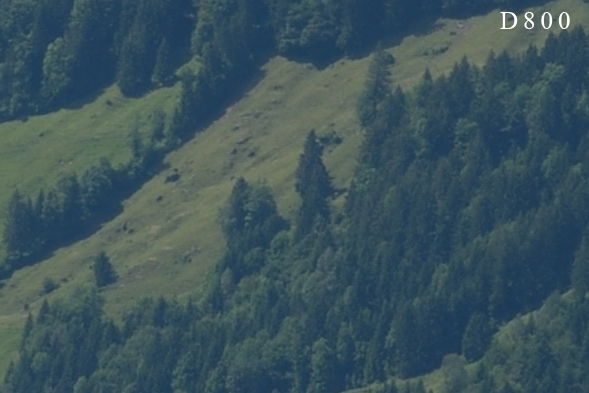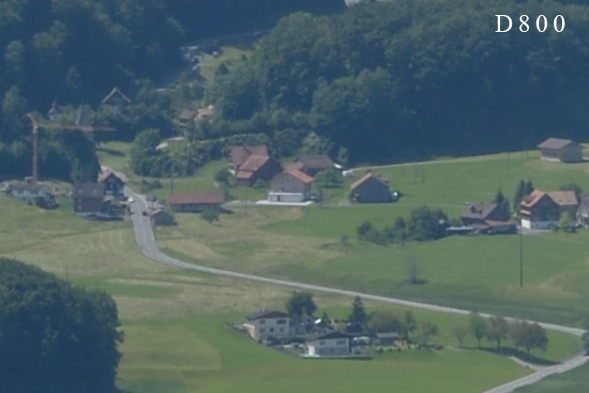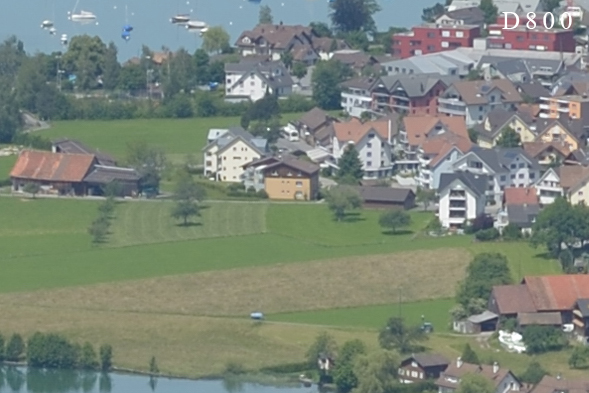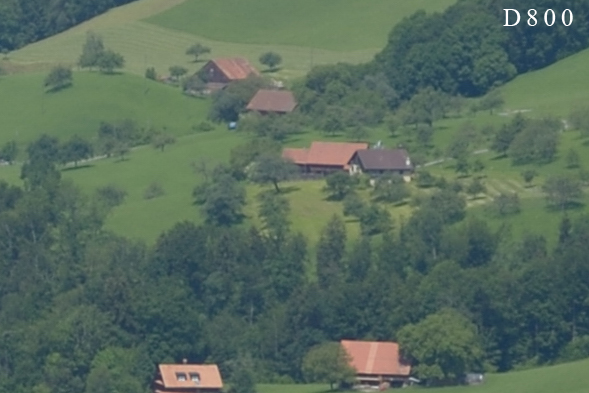

Nikon D3X vs. Nikon D800
| In May 2012, I've purchased a
Nikon D800 DSLR camera. A lot has been written about this interesting 36 megapixel
camera in the last few weeks. With its specifications, it surpasses Nikon's flagship,
the expensive 24 megapixel D3X camera: The D800 offers almost everything the
D3X has and a lot more - for a third of the price.
The D800 is the most demanding DSLR I've ever worked with. If one wants to squeeze out 36 megapixels of resolution - with sharpness from edge to edge, lenses have to be used at the right aperture. With the camera handheld, I've shot an abundant amount of slightly blurred images during the last few weeks. It's nothing to worry about - shooting the same scene several times and dialing shorter exposure times usually solves that problem. Still, the Nikon D3 was a walk in the park in comparison. |
When used with care, the D800 offers impressive resolution with
an incredible noise performance outclassing older cameras with larger pixels (though, noise-wise,
it can't hold a candle to the Nikon D3S).
The 36 megapixel output of the D800 allows for slightly larger prints than the D3X output (for a given resolution, e. g. 300 dpi). Below, a D3X and a D800 image printed at the same resolution are overlayed in two different ways to put things into perspective. |
 |
|
 |
|
|
In theory, the D800 should offer more resolution than the D3X, but does it out in the field?
I've compared both cameras on a tripod with mirror lock-up and remote release, using
the same settings (same lens, aperture, exposure time, color temperature). A Nikon
AF-S 50 mm f/1.4G lens was used - a very good performer on a D3X / D800 when closed
down to f/5.6 - f/9.
I've used the center autofocus field to minimize focus errors. In addition I've shot the same scene several times with each camera. There were no inconsistencies (due to focusing errors or camera shake on tripod). On the monitor, the colors of both cameras look quite similiar when the same color temperature is set. |
You can download the full resolution
comparison shots (note the large file sizes; further analysis see below):
Nikon D3X NEF file 1 (60 MB!) Nikon D3X JPG file 1 (13 MB) Nikon D800 NEF file 1 (85 MB!) Nikon D800 JPG file 1 (15 MB) Nikon D3X NEF file 2 (60 MB!) Nikon D3X JPG file 2 (13 MB) Nikon D800 NEF file 2 (85 MB!) Nikon D800 JPG file 2 (16 MB) |
 |
|
 |
|
 |
|
 |
|
 |
|
| 100 % crops (589 x 393 pixels) from the D3X and D800 images (working at 1/320 s f/9 and ISO 100). The position of the crops is shown in the top image. | |
| As can be seen, the additional amount of detail in the D800 image is there but hard to detect. While going from a 12 megapixel full frame sensor (Nikon D3) to a 24 megapixel sensor (Nikon D3X) adds a lot of detail, going from 24 megapixels to 36 megapixels (D800) isn't a game changer. At f/9 (the aperture used for the above test shots), diffraction already kicks in, limiting the resolution of a D800 sensor. At f/9, even the D3X is diffraction limited. We would have to choose f/5.6 - f/7.1 to get enough resolution over most of the frame for the D3X. But at that aperture, depth of field is too small for landscape work. I usually use f/8 or f/9 on the D3X for landscape work (as a good compromise between maximum depth of field and minimum diffraction effects). | Out of camera, D3X
images look a tiny bit sharper than D800 images (with the exact same sharpening
applied). Since Nikon has changed their sharpening settings in different cameras
this doesn't tell us much. If D800 images are downsized to 24 megapixels and
sharpened, they look at least as good as the D3X images (usually slightly better).
The second test shot (see below) was taken at f/8. The results are similiar. |
 |
|
 |
|
 |
|
 |
|
 |
|
| 100 % crops (589 x 393 pixels) from the D3X and D800 images (working at 1/320 s f/8 and ISO 100). The position of the crops is shown in the top image. | |
| In conclusion, the Nikon D800 offers more resolution and a long list of additional features over the much more expensive Nikon D3X. Dedicated photographers have little reason to buy a second-hand Nikon D3X instead of a Nikon D800. A much better battery life, a better button layout, a lock button e. g. for studio photography, two CF cards instead of one CF & one SD card, a built-in vertical release, a voice memo option and a slightly higher frame rate (which drops to 1 fps in 14-bit mode) are not enough to convince non-professionals to jump to a second-hand D3X. | Second-hand prices for the Nikon D3X have dropped during the last few weeks but are still on a high level (considering the $3000 price tag of a D800). And, as far as I can tell, they don't sell well (even in good condition). |